- Volume 46 | Permalink
- Print article
- Download PDF 2.8mb
III. Issues
Discussions on the T’apkok monument are exceedingly complicated, but overall they revolve around two main themes. One is its association with an early form of esoteric Buddhism on Silla soil; the other is the relevance of reading the monument as “Four Directional Buddhas.”
1. Myŏngnang 明朗 Connection?
The entire case for defining the T’apkok monument as a material corollary of an embryonic phase of esoteric Buddhism stems from a Japanese scholar’s site report during the Japanese colonial period (1910–45). The second volume of a series titled Catalogue of Treasures and Ancient Sites of Chosŏn (Chōsen hōmotsu koseki zuroku 朝鮮寶物古蹟圖錄), The Buddhist Monuments of Namsan in Kyŏngju (Keishū Nanzan no busseki 慶州南山の佛蹟), was published in 1940; it represents the earliest modern research on the subject. Included in the catalogue was Oba Tsunekichi’s 小場恒吉 report, which stated:
Considering that a roof tile fragment bearing an inscription of “Sininsa 神印寺” was discovered in the [T’apkok] area before, we can infer that a magnificent Buddha Hall had once been constructed here.[12]
Given that a masterpiece like this could be achieved in the past using a gigantic rock cliff, we can certainly presume that the adjoining monastery with halls and pagodas also looked spectacular. Accordingly, it is worthwhile to consider Mr. Ōsaka’s mention that it is identified as Sininsa based on the inscription of a roof tile excavated from this temple site.[13]
Several scholars have accepted the value of this report in explaining the T’apkok site’s doctrinal orientation.[14] The temple name Sininsa encouraged the assumption that the site was related to the Sininjong 神印宗 school, which with the Ch’ongjijong 摠持宗 constituted two major streams of esoteric Buddhism on the Korean peninsula.[15] Similarly, it was argued that Myŏngnang, the presumptive founder of the Sininjong, was somehow involved in this site.
Myŏngnang’s active role in Silla’s unification war was clearly delineated in the Samguk yusa 三國遺事 (Memorabilia of the Three Kingdoms).[16] It provides two accounts about Myŏngnang’s family background, study, and ritual practice: one in the section titled “King Munmu whose posthumous title was Pŏmmin (Munhowang Pŏmmin 文虎王法敏)” and the other in “Myŏngnang Divine Seals (Myŏngnang Sinin 明朗 神印).”[17] The latter records that Myŏngnang was born to Sagan Chaeryang 沙干才良[18] and Lady Namgan 南澗夫人 (Pŏpsŭngnang 法乘娘). His mother, Lady Namgan, was born to Sop’an Murim 蘇判 茂林[19] and was the sister of the famous vinaya master and state preceptor Chajang 慈藏 (fl. 636–50), thus making the latter Myŏngnang’s maternal uncle.[20] Myŏngnang’s two brothers, Kukkyo taedŏk 國教大德 and Ŭian taedŏk 義安大德, held prestigious status; the honorific title of taedŏk 大德, or Monk of Great Virtue (Sanskrit: bhadanta), was bestowed upon monks who had performed noble and virtuous actions.[21] As the noble scion of such an eminent family, Myŏngnang had the privilege of traveling to Tang China in 632; after three years of study, he returned to Silla.[22]
When the Tang navy invaded Silla in 670, King Munmu 文武王 (reigned 661–81) consulted Myŏngnang, who was believed to have already mastered the “Munduru 文頭婁, 文豆婁 Secret Method” in the Dragon Palace.[23] Munduru is a transliteration of mudra, which in this case implies esoteric practice and is often translated as Divine Seals (Sinin 神印).[24]
Myŏngnang suggested to the king that they should build Sach’ŏnwangsa in Sinyurim 神遊林 (Divine Wandering Forest), south of Nangsan.[25] Due to time constraints associated with the national crisis, they were forced to build a makeshift version of Sach’ŏnwangsa using multicolored silk and then install temporary images of the Five Directional Deities (obangsin 五方神), made of grass and straw, which was followed by the ritual of the “Munduru Secret Method.” [26] Myŏngnang and twelve eminent Yoga (Korean: Yuga 瑜伽) monks led the Munduru ceremony, after which the entire Tang navy was destroyed before the first battle.[27] To commemorate this miraculous victory, the Unified Silla court actually constructed Sach’ŏnwangsa in 679, the nineteenth year of King Munmu’s reign, on this de facto sanctified site, chosen to represent the unification war; its ruins remain today at the foot of Nangsan.[28]
In sum, if we accept as credible the report of a roof tile inscribed “Sininsa” and its possible relationship to both Sininjong and Myŏngnang, the T’apkok site seems similar to Sach’ŏnwangsa. Both can be associated with “state-protection Buddhism” as well as with the esoteric practice of Munduru. However, this interpretation has been questioned because the actual tile described in the Japanese scholar’s report is missing. No photo of the tile exists; no one has seen it since, and the author himself probably never saw it in person. Some scholars, therefore, do not accept the site’s association with Sininsa and doubt Myŏngnang’s involvement in T’apkok.[29]
Considering the lack of physical proof, dismissing Oba’s report may seem justifiable. In fact, most recent scholarship does just this. I believe, however, the comparison to state-sponsored Sach’ŏnwangsa is so compelling that it cannot simply be abandoned. It is helpful to remember that T’apkok is located at a visible distance from Sach’ŏnwangsa. To be more specific, the T’apkok area offers an exceptional view of the north toward Nangsan, and this view includes Sach’ŏnwangsa at a distance of 700 meters (figs. 1, 11). Its physical proximity suggests that T’apkok carvings and adjacent monuments were somehow connected in a shared socioreligious atmosphere, in which Silla was viewed as a consecrated Buddhist realm, even if it did not directly share in the collective yearning for state protection from the Buddha.
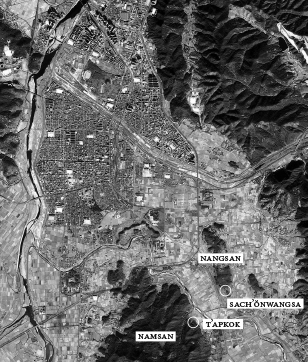
Sach’ŏnwangsa was not only a sacred site that represented Silla’s unification war but also a magnificent construction in terms of visual spectacle. Unfortunately, only parts of the foundation remain; yet it still covers an area 105 meters long on the north-south axis and 73 meters long on the east-west axis. Based on site examinations, scholars have shown that from the south gate, one had to climb a manmade hill, where the temple cloister had been built. Because it was easily visible, the temple architecture must have been imposingly grand.[30]
Sach’ŏnwangsa also had a government office called the sŏngjŏn 成典, which was charged with managing and refurbishing the monastery.[31] Such offices existed in a few other temples, including Hwangnyongsa.[32] Temples with such offices did not belong to any individual member of the royal family or aristocrat, but they were recognized as state temples, kukch’al 國剎, that belonged to the government and by extension to the entire kingdom. Among the temples with Sŏngjŏn offices, Sach’ŏnwangsa had the largest and most complicated organization. Such extensive state involvement indicates that Sach’ŏnwangsa was the focus of the court and played a central role in the state activities.
Typically, in an area dominated by a major monument, any monument built in the vicinity will be influenced by the existing one. In constructing another site for worship close to the court-sponsored building, although with a different form of rock carving, the patrons at T’apkok presumably had a particular purpose in mind. The imposing presence of double pagodas on the north wall and the massive statue of a freestanding Buddha on the south ground at T’apkok—even though the latter was likely added later—as well as the flowing lines of each skillfully carved motif collectively suggest some artisanship (admittedly not the most sophisticated or sumptuous) and considerable financial support. While Sach’ŏnwangsa was intended as a state temple, a monument such as T’apkok likely received patronage from an individual member of a prominent family.
Several historical connections suggest that Myŏngnang had ties to Namsan both through family and his esoteric practice. First, in terms of family ties, Namsan was recognized as the place where Lord Murim 虎林公,[33] father of Chajang and grandfather of Myŏngnang, gathered with high officials to decide important state matters.[34] Second, Namgansa 南澗寺 at Changch’anggok 長倉谷, at the northwest foot of Namsan, was associated with and took its name from Lady Namgan, Myŏngnang’s mother.[35] Its surrounding areas are thought to have been the manor of the family of Chajang and Myŏngnang.[36] Today the temple site is reduced to its flagpole bases and other scattered fragments; it sits just below the foot of Namsan and is connected to T’apkok by a walkable path (fig. 1).[37] Lastly, Kŭmgwangsa 金光寺 at Changch’anggok was originally Myŏngnang’s personal residence.[38] According to the Samguk yusa, he came back with one thousand strings of gold, given to him by the Dragon King as payment for his teaching, and mysteriously went underground beneath his own house, only to soar from its well.[39] He donated his house so it could be converted into a monastery and embellished its pagoda and Buddha images with the gold that he had received.[40] This site is also located near Namgansa.[41]
Despite this circumstantial evidence, Myŏngnang’s connection to the T’apkok monument has been elusive and thus hard to support. However, ignoring those fragmentary indicators might be a mistake. T’apkok is located between Sach’ŏnwangsa and Myŏngnang’s family base in the Changch’anggok area. Between these two spots, a massive granite boulder sits atop a freely flowing mountain spring, and it presumably presented a prime location to carve divine images and create a proper shrine.
Returning to the story of the Sininsa roof tile, the excavation of tiles inscribed or stamped with temple names from nearby sites, such as Sach’ŏnwangsa[42] and Ch’angnimsa 昌林寺,[43] on which the style and method of seventh-century craftsmanship has been preserved suggests that it is also quite possible to uncover Unified Silla tiles with inscribed names at adjacent sites on Namsan. Roof tile-ends with patterns (yumun wadang 有文瓦當) also have been unearthed near the north cliff of the T’apkok boulder.[44]
Further, given the character of Oba’s report, perhaps his observation should be seen as credible. His note about the Sininsa roof tile was included in a catalogue of more than a hundred black-and-white photos with meticulous drawings and measurements executed by the Japanese colonial government.[45] The catalogue was not a light journalistic write-up but rather a volume of an official series based on thorough site research.
Interestingly, Oba cited Ōsaka’s finding of the roof tile but did not further explain Ōsaka’s role. Neither did Korean scholars studying the T’apkok monument, and they seemed to dismiss his observation.[46] The catalogue’s foreword, however, lists people who helped with the site research, including Ōsaka Kintarō 大坂金太郎,[47] a well-known researcher specializing in Silla monuments. Ōsaka wrote several articles and books on the temple sites, steles, and artifacts.[48] Along with fellow members of the Society for Preserving Kyŏngju’s Ancient Sites (Keishū koseki hozonkai 慶州古蹟保存會), he published the Site Report of Ancient Sites, Monuments, and Objects of Kyŏngju (Keishū koseki oyobi ibutsu chōsho 慶州古蹟及遺物調書) in 1931. In that report, Ōsaka matched temple names known from texts to actual ruins, providing a foundation for later research.[49] He was also head of the Kyŏngju branch (Keishū bunkan kanchō 慶州分館館長) of the Japanese Colonial Government Museum (Chōsen Sōtokufu hakubutsukan 朝鮮総督府博物館). His best-known achievement, however, was a discovery on the hill near the Sŏkchangsa 錫丈寺 temple site in 1935: the famous “Stone Tablet with the Inscription of an Oath dated to the Imsin Year (Imsin sŏgi sŏk 壬申誓記石)” from Old Silla, possibly dated to 552 or 612.[50]
More remarkable in the current discussion, however, is that Ōsaka recalled that this stroke of luck occurred on a day when he had been searching for something completely different—tiles inscribed with patterns, temple names, or written characters associated with the Silla’s famed sculptor-monk Yangji.[51] Ōsaka knew that records show Yangji resided in Sŏkchangsa, so he went to that area with the hope of finding some remnant inscriptions at the temple site. While his ultimate contribution on this day was the stone tablet, it is important that he was searching, in fact, for those temple tiles. In short, Ōsaka knew Silla epigraphy and was fascinated by it, as evidenced by his regular excursions to search for new materials. His familiarity with the artifacts in Kyŏngju and expertise in Silla inscriptions suggests that his discovery of the Sininsa roof tile should not be ignored or brushed aside.
Nevertheless, no matter how tempting it might be to assume the reliability of the record regarding such a chance find, it is far from proven. We are, for now, left with fragmentary evidence from various sources—historical texts, site reports, and other physical remnants—that appear to help us comprehend the T’apkok monument, but they remain insufficient. Although Myŏngnang’s connection and Sach’ŏnwangsa’s echo at the monument is hardly deniable, the T’apkok monument is not yet interpretable under the umbrella of esoteric Buddhism in Silla. In the end, the “mysterious” roof tile inscribed with “Sinin,” if it could be located, might be a critical piece of the puzzle. Perhaps a more complete picture of the role of T’apkok in the history of Silla Buddhism and its visual culture will become clearer after the systematic excavation of the T’apkok temple site itself.
2. The Four Directional Buddhas
The literature often refers to the carved deities as the Four Directional Buddhas at T’apkok (T’apkok sabangbul 塔谷四方佛).”[52] Because the monument has various deities carved on each of its four sides, this approach is understandable. Some researchers naturally have focused on identifying the images that constitute this set of four Buddhas.[53] Most have interpreted it as including representations of Akṣobhya (Achu 阿閦), Ratnaketu (Baoxiang 寶相), Amitāyus (Wuliangshou 無量壽), and Madhura-svara-nirghoṣa (Weimiaosheng 微妙聲).[54]
The Four Directional Buddhas were said to have first appeared on the Korean peninsula at the end of the Three Kingdoms and during the early Unified Silla period.[55] The first textual account concerns the four-sided Buddhas at Taesŭngsa 大乘寺 on Sabulsan 四佛山 in North Kyŏngsang province, which, according to the Samguk yusa, were made in either 587 or 624.[56] According to legend, a square boulder, its sides carved with four Buddha images and wrapped in red silk, fell from the sky on top of the mountain.[57] Its mysterious appearance suggested a foreign origin, while the copious red silk emphasized its precious and miraculous nature. The boulder is now so badly eroded that a complete reading of its iconography is impossible, but a seated Buddha is depicted on each of two sides, and a standing Buddha is on each of the other two sides.[58]
Many scholars have regarded the sculpture at the Kulbulsa site 掘佛寺址 as a prime example of this iconography, but there, each side has its own distinct theme and scale, without any apparent unifying principle (figs. 12, 12A).[59] Kim Rina has reviewed possible sources for this monument and suggests that it is a collection of popular images from the time rather than a coherent theme and composition based on a single visual source or series of texts.[60]
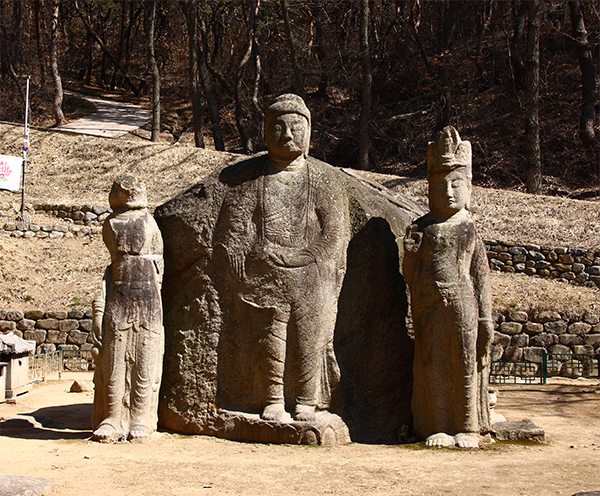

A more remarkable point about the Kulbulsa carving is the legend in the Samguk yusa, which records that it had been excavated. On his way to Paengnyulsa 栢栗寺, King Kyŏngdŏk (reigned 742–65) heard mysterious sounds beneath the ground and ordered his men to dig. When they did, they found a boulder carved on four sides.[61] This legend may hold the key to understanding this image, offering a better fit than the Four Directional Buddhas. In a sense, the monument was alive, producing sounds that appeared to be coming from the earth, and was said to have been found as a finished piece. Just like the Taesŭngsa boulder that descended from above, this Kulbulsa monument has mysterious origins, but here, they are indigenous to Silla, as it was believed to have been underground long before its discovery.
The indigenous nature of this boulder is pivotal to recognizing the Unified Silla territory as a consecrated Buddha Land, presided over by Buddhas and protected by their sacred power. It is believed that Buddhas are inherent to Silla just as the finished piece of Buddhist carving is inherent to its soil. Such an idea is applicable to the T’apkok carving as well as Kulbulsa and presumably is embedded in all Namsan monuments. The T’apkok carving is believed to have been created before the Four Directional Buddhas became an established motif on the peninsula. While sculptures at Taesŭngsa and Kulbulsa required some shaping and preparing of the boulder and its surfaces, T’apkok preserves the natural shape of rock, indicating that materiality and “site-ness” were goals here. Rather than carving one representative deity on each side, the sculptor decided to embellish the available space completely, presumably to depict the splendid realm of Buddha(s) to maximum effect.
Despite its profuse images, the T’apkok monument is peculiar in that its deities lack specific gestures; all hands are covered by robes, the hem of each sticking out in front. Possibly this serves to extend the meditation mudra, but that is not a common mudra for primary Buddha images. Such a mudra often is seen in meditating monastic figures or serial Buddhas in steles and murals in China and Central Asia.[62]
This specific mudra, both hands covered by a garment drape, can be found in some older Korean sculptures. Bronze plaques from Kimje 金堤, North Chŏlla province, dated to seventh-century Paekche, show a main Buddha (fig. 14) as well as rows of small, seated Buddhas with that mudra.[63] Other works from early Unified Silla bear miniature Buddhas with the same mudra in multiple, as seen in the Yŏn’gi 燕岐School steles (figs. 15, 16), and the cliff carving at Pukchiri in Ponghwa (fig. 17). The relief carving at Porisa 菩提寺, close to T’apkok, is perhaps the only instance known to date in which a single main Buddha makes such a gesture (fig. 18).
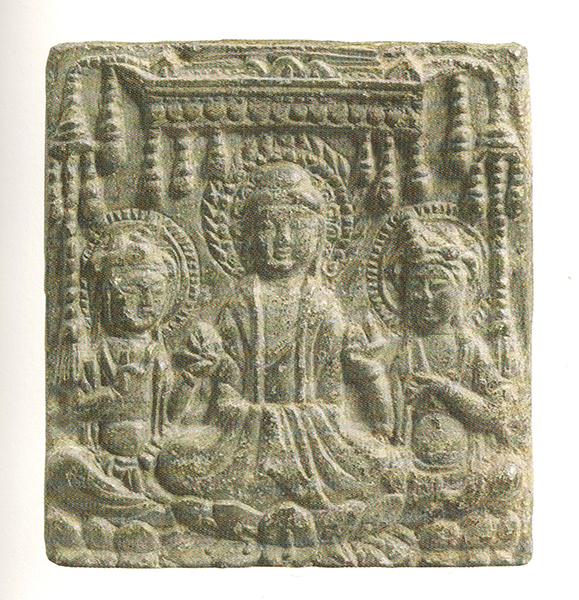
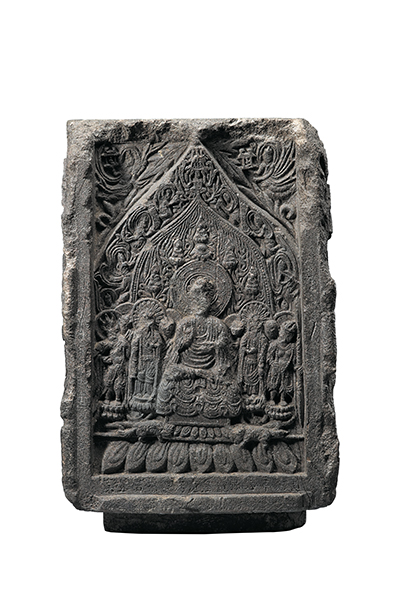
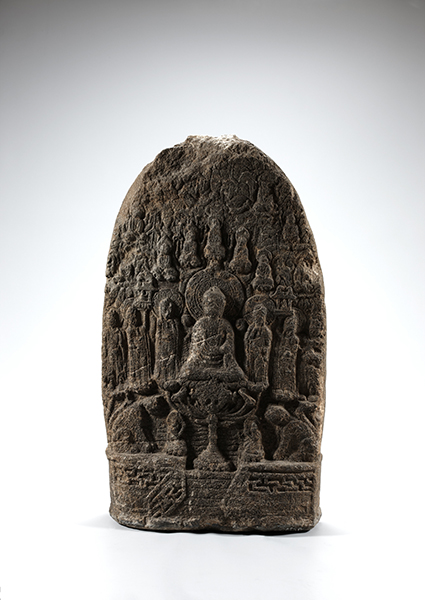
A mudra is often critical to establishing the identity of a depicted figure. Although at times a certain mudra may lead a viewer to conflate identities between two different Buddhas, assigning a distinct mudra for each image in a single sculpture essentially helps to differentiate one deity from another. The reading of the T’apkok carving as Four Directional Buddhas, therefore, becomes most puzzling since they all share the same mudra. Other Unified Silla works, such as the one from Ch’angnimsa pagoda on Namsan, show a discernible mudra for each Buddha (fig. 19). The four seated Buddhas on the top sides of the pagoda show four different mudras: the dhyāna mudra, bhūmisparśa mudra, hands holding a round object, and hands covered by a robe. Although the Buddhas’ identities are unclear, the artist clearly sought to distinguish one Buddha from another.
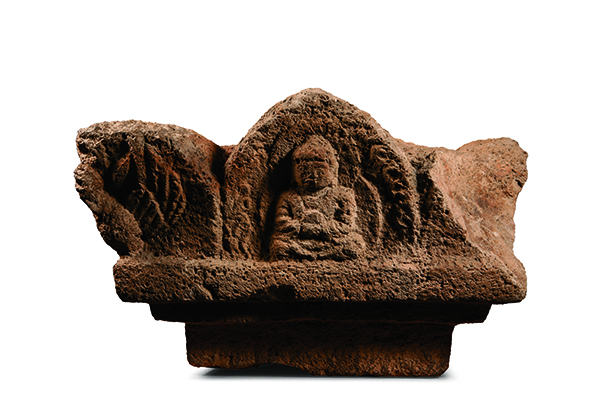
At T’apkok, on the other hand, not only do the Buddhas share the same mudra, none of them can be singled out as representing any of the four directions. This suggests that the T’apkok carving is not a clear example of the Four Directional Buddhas or any associated iconographic arrangement.
Ars Orientalis Volume 46
Permalink: https://doi.org/10.3998/ars.13441566.0046.004
For more information, read Michigan Publishing's access and usage policy.











